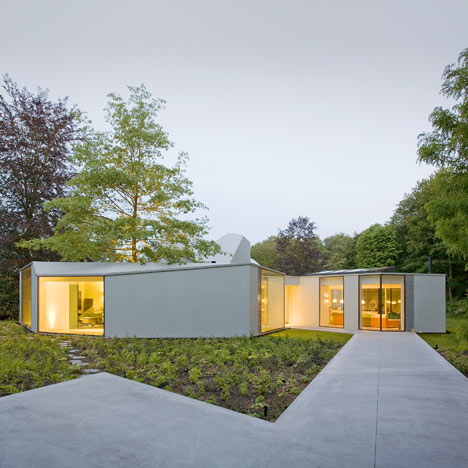
Villa 4.0 by Dick van Gameren
Dutch architect Dick van Gameren has converted a family house outside Hilversum by punching three faceted skylights through the roof and driving a corridor through the middle.
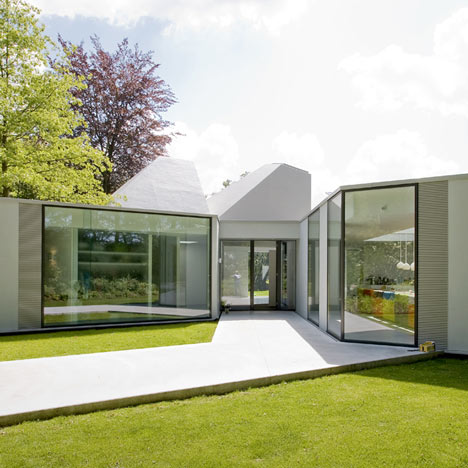
The project has been named Villa 4.0 since this is the fourth major rebuilding of the single-storey house, which was built in the sixties and which has a plan based on hexagons.
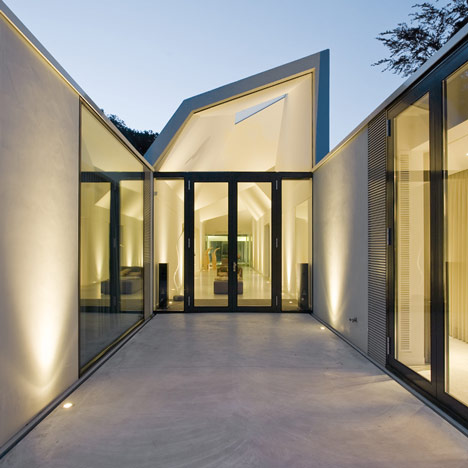
Floor-to-celling glazing surrounds a new sunken living room at the back of the house.
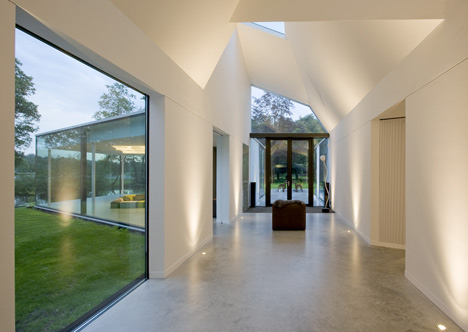
A hexagonal block in one corner encloses three bedrooms with bamboo floors.
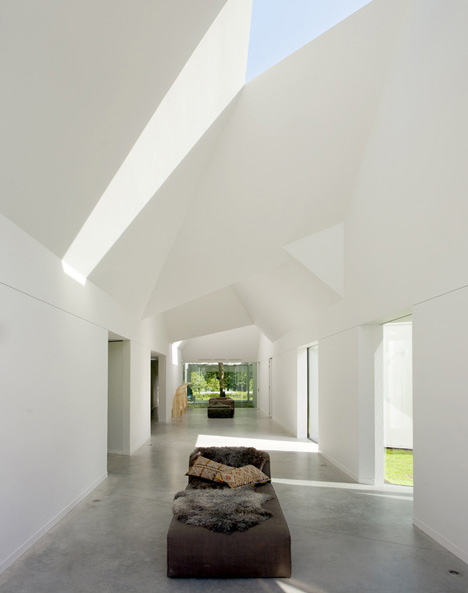
Other Dutch houses recently published on Dezeen include one with a fabric facade and another with an inwardly pitching roof - see all our stories about Dutch houses.
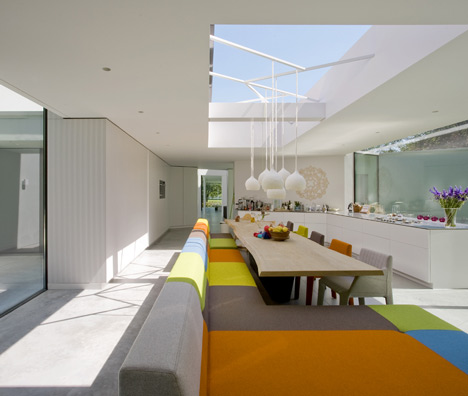
Photography is by Marcel van der Burg - Primabeeld.
The following is provided by the architects:
When the client set off with his family on a round-the-world sailing trip in 2007, he had no idea that this would lead him to the villa in which he lives today. Daily life on board ship was quite different from that on land: you had to generate your own electricity, make potable water with a watermaker, separate waste products down to the smallest scale and of course exploit the wind for travel purposes. All at once, things he and his family had scarcely considered on land became crucial matters. Back in the Netherlands, this fact of automatically considering aspects of sustainability became the springboard for their new house: Villa 4.0.
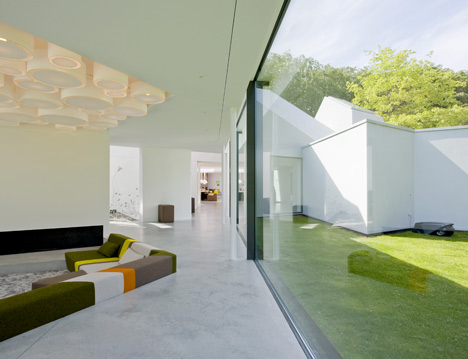
In the leafy Gooi region around Hilversum they found an attractive plot of land containing a simple bungalow dating from 1967 on a hexagonal ground plan. This became the stepping-off point for a major building project involving many specialists and with sustainability taken up in the plans wherever possible. So instead of demolishing the bungalow - which had already been radically altered in 1972 and 2001 - it was to be recast. The reuse principle is also in evidence in the garden design; trees and bushes have been replanted to fulfil a new duty in the garden and felled trees are stored away as firewood for the high efficiency wood burning stove in the kitchen. Heat pump, solar boiler and LED lighting are among the energy-efficient solutions deployed for handling all the big energy consumers, from heating, cooling and hot water to electricity. Some are feats of technology, others are proven yet largely forgotten solutions such as a clothes horse for drying clothes or a bicycle as the principal means of transport.
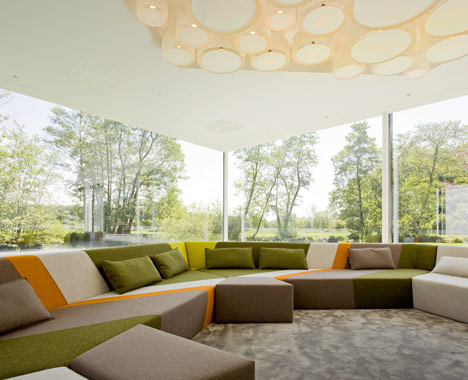
Design
Although the many modifications and additions had made the house bigger, it had also become increasingly inward-looking. The expanding wings were steadily enclosing the heart of the house with the hall and living quarters, and direct contact between the house and the magnificent surroundings was largely lost. The original detailing and material form were consistently adhered to during all previous interventions but the result was now thoroughly outmoded and of a poor technical quality.
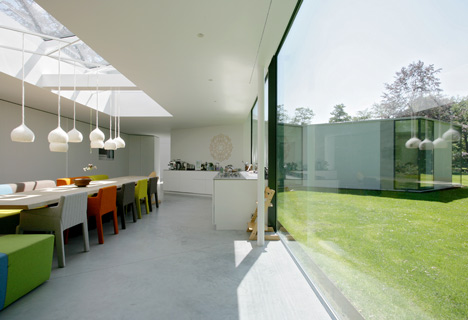
The house has now been given its fourth look. Dick van Gameren Architecten was commissioned for the design, the principle guiding this most recent intervention being to create a house that is much more sustainable and able to reinstate the lost relationship between it and the landscape.
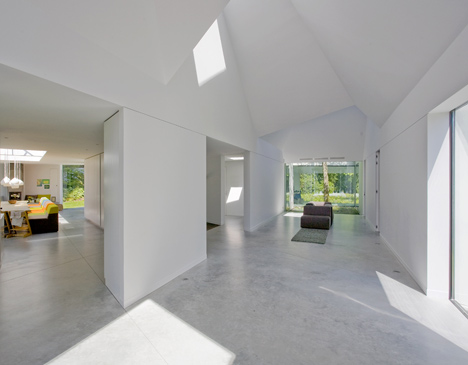
Dick van Gameren Architecten kept as close as possible to preserving the existing house, which gave the first step towards a sustainable end result. Taking the existing structure as the basis, the outer walls and roofs were modernized by adding insulation and replacing all windows and larger areas of glazing. The walls in the central section of the house were removed to create a new living hall looking out onto the surroundings on four sides. In addition, the physical bond between house and landscape has been consolidated by an all-glass pavilion attached to the living hall that reaches out to the brook flowing past the house.
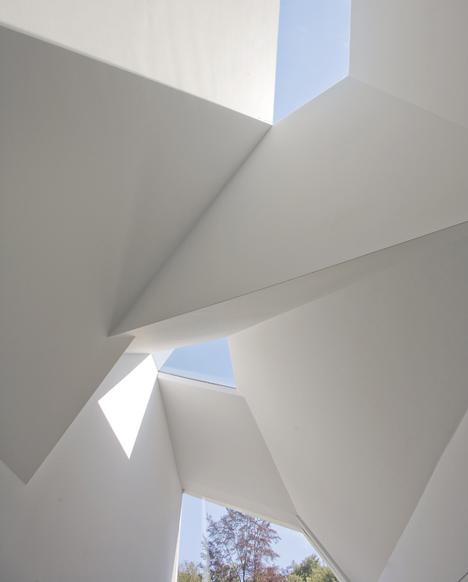
Interior
The client desired a timeless interior. To this end the IDing interior design firm took ‘interior follows exterior’ as its stepping-off point and gave most of the rooms concrete floor slabs. This is because of that material’s durable and maintenance-friendly quality but also because it weds well with the finish of the external walls. Expansion joints made in the concrete floor continue the direction taken by the walls both inside and out onto the concrete paths in the garden. This strategy picks out the sight lines in interesting ways. The corners between walls, the kitchen, the sunken sitting area and the desk in the study all follow the architecture of the bungalow.
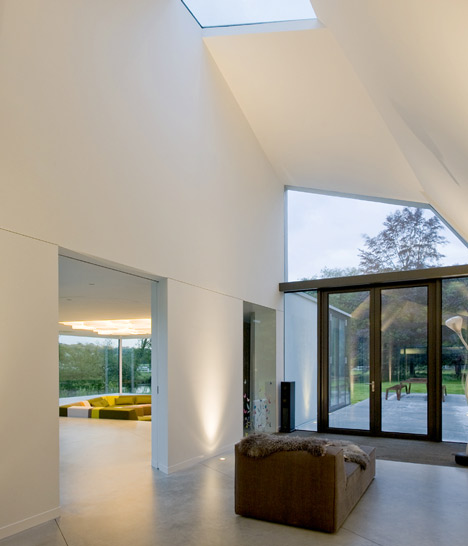
The harmony between internal and external space was a key design determinant, particularly in terms of colour, sight lines and lighting. Besides the aforementioned expansion joints many natural colours have been applied to ensure the house’s sense of timelessness. Exceptions to this are the natural wool felt upholstery of the settee in the kitchen and the sunken sitting area in the living room, which are a mass of colour. Curtains, all of which can be drawn up into rails in the ceiling, are in neutral tints.
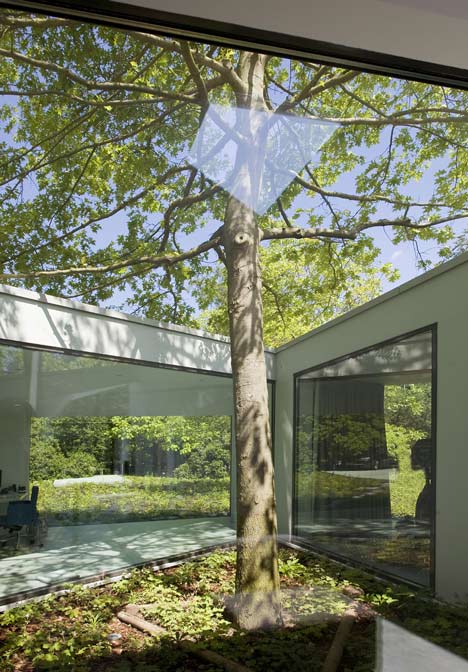
Sustainability informs as much as possible of the interior. Thus, the kitchen boasts an ecological, high efficiency wood stove which after two heating sessions of 1.5 hours provides 24 hours of agreeable warmth. Not just that, the stove achieves low emission at high temperatures. The bedrooms have bamboo floors as a sustainable alternative to wood. Bamboo was chosen because it is a rapidly lignifying grass of extremely fast growth and therefore far more sustainable than any wood type. All lighting inside the house is LED based. Once again this choice is informed by sustainability; an LED lamp lasts roughly 50 times as long as an incandescent lamp and consumes about 90% less electricity.
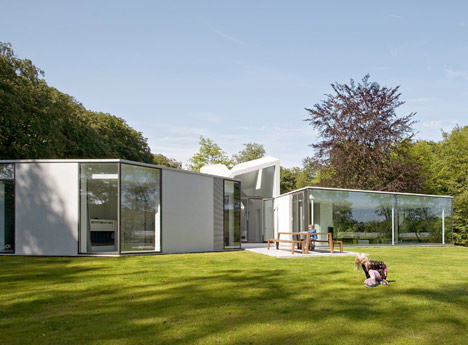
Landscape
Like all the other specialists, landscape architect Michael van Gessel drew inspiration from the existing situation: magnificent beeches on the high-lying avenue, their branches reaching far across the steep slope, the garden’s choice position directly along the brook and several magnificent trees and shrubs round the house inspired him to draw up a new garden design whose reuse of existing plants and trees accorded well with the wishes of the client.
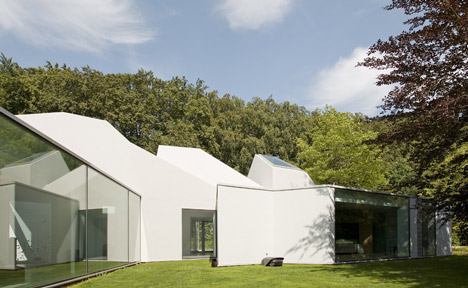
The special areas of the garden have been emphasized to the full by removing all extraneous elements - conifers, the many maples, low shrubs and the bare slope - to make room for a large lawn and a generous planting or replanting of perennials and flowering shrubs along the property boundary. Throughout the year, the garden presents an ever-changing though always ‘natural’ picture with a wealth of flowers and leaf shapes appropriate to both the underlying principle and the changing orientation to the sun.
A salient detail is that a large oak has been planted in the patio of the house. This makes it seem as if the house has detached itself from the edge of the woods to move into the open space in full view of the sun. Like the floor of the house the hard landscaping - entrance, parking and terraces - consists of large slabs of helicoptered concrete so that house and garden, inside and outside, flow one into the other as if it were the most natural thing.
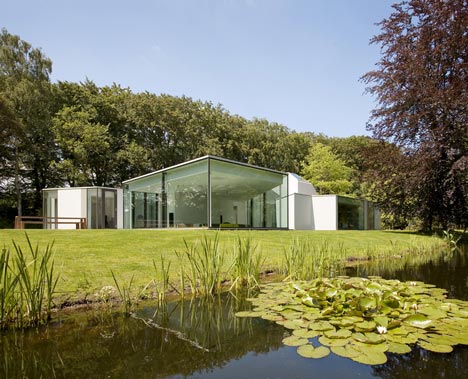
Villa 4.0 took two years to design and build and has now been appropriated by the client.
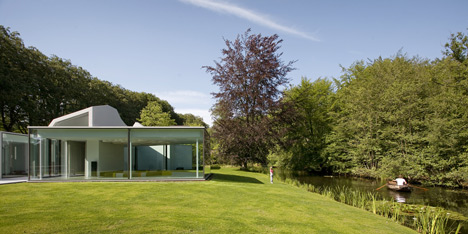
More on aspects of sustainability in Villa 4.0 - The Netherlands
Sustainability is a concept that has been crucial in informing all components of the design, construction and daily use of the house. Rather than create an icon of sustainability, the idea was to consider practically and level-headedly at every step how the house could be least taxing on the environment in both the short and the long term. Key points of departure were maximum reuse of built elements and materials already on site and the use of sturdy and proven techniques to achieve the lowest possible energy consumption. The clients see a sustainable house not as the end of the story but as an inspirational spur to a way of life that places concern for mankind and nature and care of our planet at centre stage.
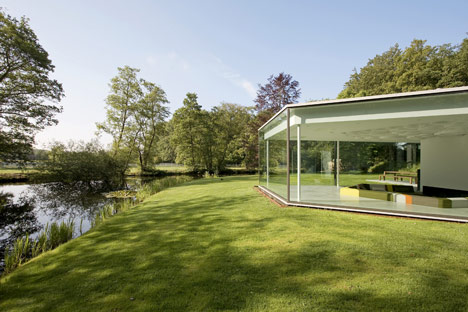
Reuse
The design steps off from the existing house, so that along with comprehensively improving the quality of both space and building performance it makes the most of the materials already on site. Components of the existing house that had to be removed have been reused elsewhere in the design where possible.
Roofs and facades have been insulated or reinsulated (R Value 3.5). The floor too has been insulated (R Value 3) and finished with a smooth continuous concrete deck floor on compression-resistant insulation. The old wood frames have been replaced with new aluminium-framed facade units of insulated glass (U Value 1.1)
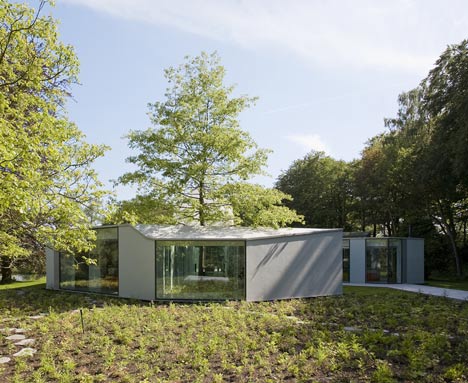
Energy and indoor climate
A floor heating system has been laid into the new concrete deck floor that can heat or cool the rooms using low temperature heating (water < 35°C). A second system has been installed in the bedroom ceilings to facilitate additional cooling in summer. The entire system is fed by a thermal storage unit. All rooms can be regulated individually. Self-generated energy is not being treated as an option for the time being. The surrounding trees mean that there is much shade for a large part of the year and little wind. The part of the roof that does catch the sun all year long is provided with a solar boiler for hot water facilities (head pipe system).
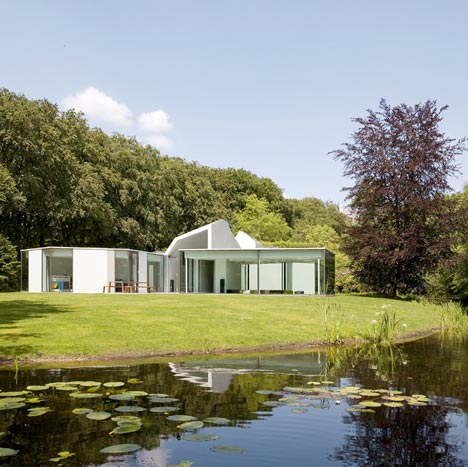
Ventilation of the house is premised on the natural circulation of air throughout the building. Ventilation units in the outer walls make it possible to regulate the exact quantity of air entering the building. In summer, ventilation can be stepped up using a mechanical discharge system in the roof lights of the central hall. Of the two spaces with a lot of glazing, the kitchen has a glass sliding roof and the living room a roof hatch that allows for additional ventilation in warm weather. The ventilation units enable the house to be aired without having to leave windows and doors open.
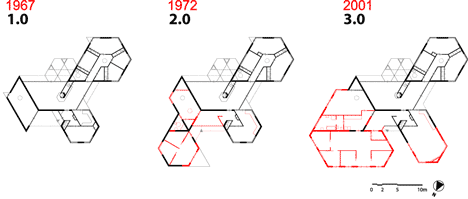
Click above for larger image
Another source of cooling is by means of a roof-top pump that draws up water from the brook and sprays it onto the roof. The water then flows back into the brook. There is a high efficiency wood burning stove in the kitchen, fuelled with wood from the garden. The heat yield supports the heat pump, thereby reducing the energy consumption of the thermal storage system. The house's open layout ensures that heat from the stove can spread throughout the house.
The living room heats up quickly in winter by being oriented to the south and having all-glass facades, and thus serves as a heat source for the house as a whole.
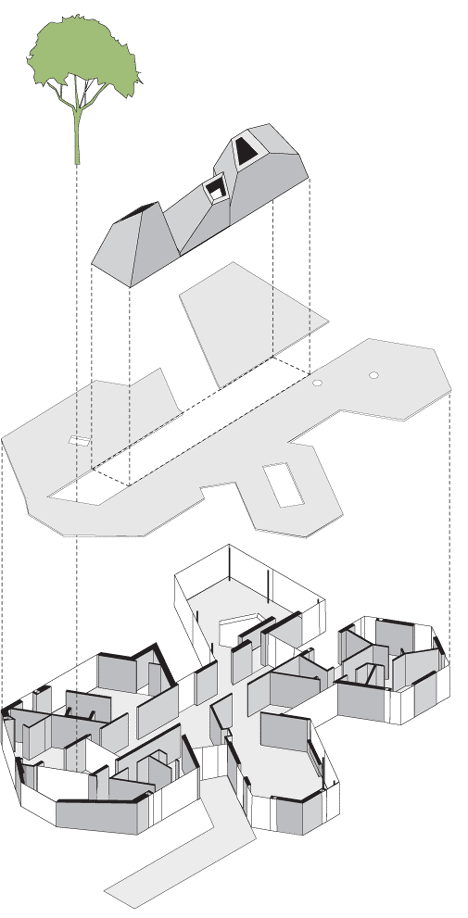
Interior
All living spaces receive daylight from more than one direction. Storage units, bathrooms and other ancillary spaces also receive daylight, some of it indirect. All artificial lighting is LED-based. Much of the furniture is built-in and where possible made of sustainable materials: wood floors and wardrobes - bamboo, kitchen cupboards - Ecoplex (poplar) laminate, settees in the living room and kitchen, curtains in the nurseries - woolfilt, floor covering in the sunken sitting area -bamboo.
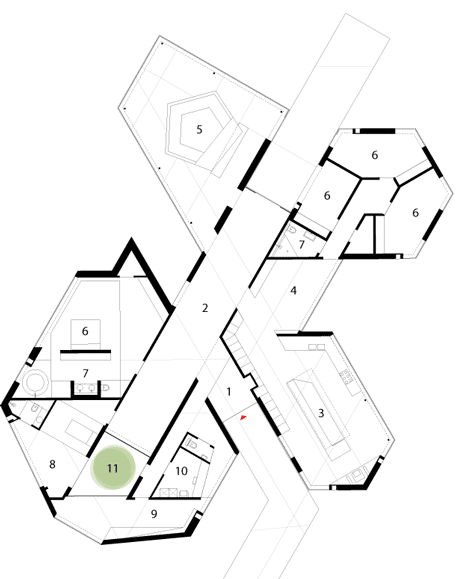
Water and garden
Rainwater on the roofs is run off directly into the brook. All waste water (greywater) is run off into a tank where it is purified organically and then discharged into the brook. Only biodegradable cleansing agents are used in the house. The new garden layout is informed as much as possible by the replanting of existing trees and shrubs. This gives a greater openness but also more privacy where this is required. The garden is sprinkled exclusively with water from the brook. An electric lawn mower robot keeps the grass at the correct height, and the planting in the garden can be tended without the need for herbicides and artificial fertilizers.